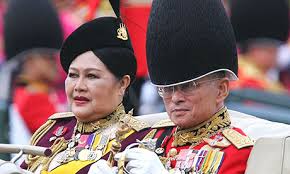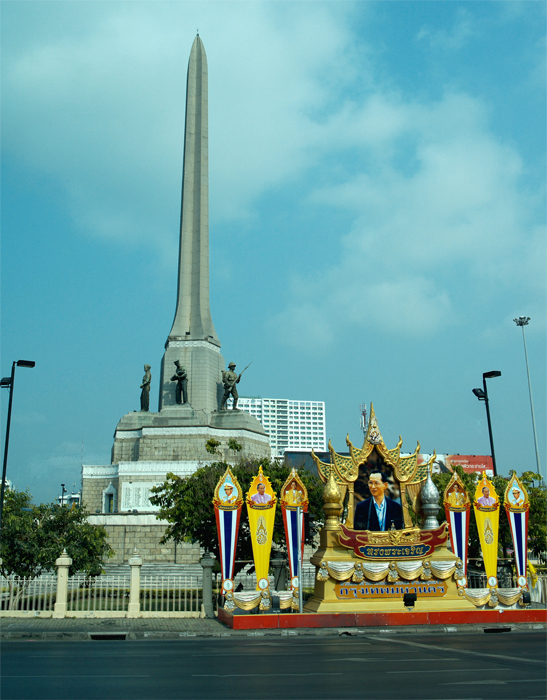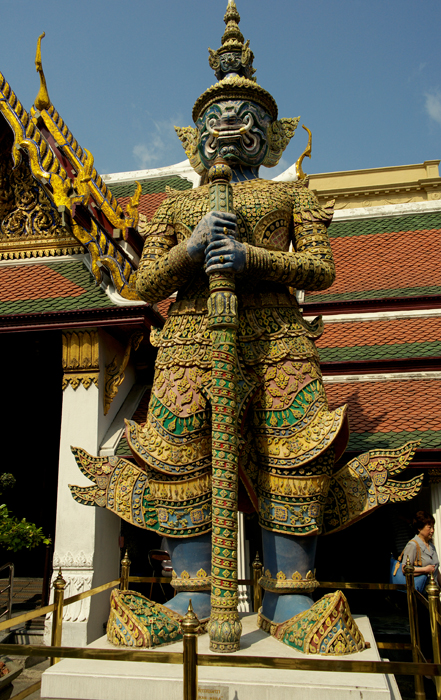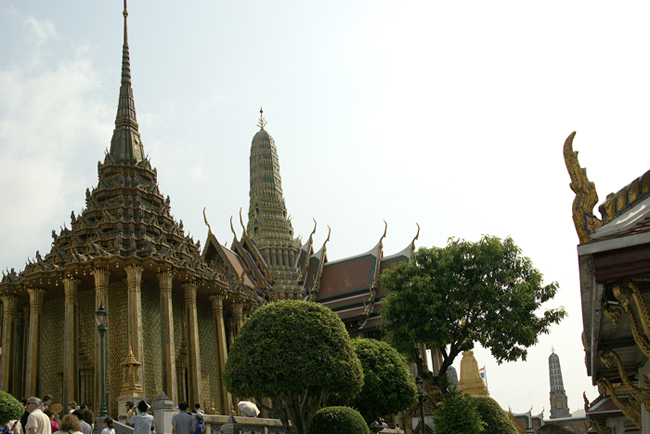|
Thailand Day 10b
|
Thailand Day
|
Thailand Day 3
|
In the morning, we took the optional tour to visit the Wat Phar Kaew, also known as the Temple of the Emerald Buddha, and the 18th century Grand Palace of the King. The two are adjacent, and over on the Chao Praya River, and were beautifully visible during the night river cruise with dinner which we had that evening. The Grand Palace was initially built in 1782, and has been renovated several times since then. It contains the former Royal Residence as well as a number of Government offices. This was built by King Rama I. The Palace and governmental buildings are very European in nature, in stark contrast to the Thai trimwork and other edifices in the compound. Again, this compound is built like a fortress, surrounded by a wall (altho not a huge, fortified wall, there are guardposts at each corner and along the midwall areas.) Also visited here was the Queen Sikrit museum of textiles (actually, a museum showing her various gowns thru the decades. In the 1960's Queen Sikrit was repeatedly named as one of the top 10 best dressed women of the world, along with Jacqueline Kennedy. Queen Sikrit was quite the beautiful woman and is still very attractive. The King, Rama IX, is King Bhumibol Adulyadej, and has ruled since 1946. King Bhumibol was born in Cambridge, Massachusetts in 1926. His father, the previous king, was studying medicine at Harvard. He then returned to Thailand and implemented a more modern system of healthcare, with health insurance available to all at a very low premium. He opened several "government run" healthcare facilities and hospitals, and is warmly remembered by the Thai people for his many efforts to modernize Thailand, after having lived abroad for so many years. Prince Bhumibol became the King of Thailand when he was only 19 years old in 1946, after the unfortunate early death of his older brother. He is now 88 years old and still in very good health. In Thailand, you will see large elaborate signage on virtually every major highway and road intersection with a photo of the King, and sometimes of the King and Queen. While the country became a Constitutional Monarchy in 1932 with a Senate, House of Representatives, and a Prime Minister. This is also when Thailand changed its name from Siam. While there is often a great deal of strife over the political end of the governing parties (as is currently occurring), the people of Thailand have a great fondness for their King. The King has some ruling powers, but most power is now held by the congress and Prime Minister. Below are photos from the internet of the young King and Queen from the 1950's and 1960's as well as more recent photos |
      |
Wat Phar Kaew - Grand Palace
 |
 |
 |
| This is the Victory Monument, commemorating the end of W.W.II. Note the homage to the King. This is a very large intersection in Bangkok. There is a similar portrait setup of the king at every major intersection of highways or major streets in every town in the country. | At the Wat Phar Kaew (Temple of the Emerald Buddha) the temple gate is guarded by these Yaksha demons . Click here for close-up of above to see the intricate artwork. | More Yaksha guards. Click here for another close-up view of the artwork. Note the intricate spiral behind the right Yak. |
 |
 |
 |
| In front of one of the gate areas |
This is a burial site for a king, and the entire thing is covered with very tiny mosaic mirrors. You can see them if you look closely. Can you just imagine the labor involved to create this? This was erected by King Mongkut - Rama IV, king from 1851-1868. This was the King who started to bring Siam into the modern phase, by establishing relationship with both the United States and with European leaders. While the French, British and Holland were annexing parts of Southeast Asia, Siam was able to remain independent and neutral. He had been a monk for 27 years before becoming the King. He worked towards introducing social improvements, including improving the conditions of slaves and women. He hired European tutors for his children, including Anna Leonowens. It is this king who is immortalized in the fictionalized story/movie "Anna and the King of Siam". Yes, Yul Brenner built this Golden Chedi. This Golden Chedi (Stupa) is actually covered with very tiny little golden mosaic tile mirrors which your can see if you CLICK HERE. |
This is the Royal Pantheon building, in which are
the statues of seven kings from the Chakri dynasty (1767 - present)
(The Rama kings). It was not open when we visited. For a closer view
of the intricate work that went into this building, click
here
|
 |
 |
 |
| I believe this is the temple in which the Emerald Buddha (actually made of Jade) is housed. Again, incredibly ornate mosaic tiles and mirrors - see close-up view |
Fu Manchu warrior guards the Golden Stupa
|
A golden warrior outside of one of the temples. Note
the jeweled insets on the statue along with tiny mirror mosaics. See
close up view
|